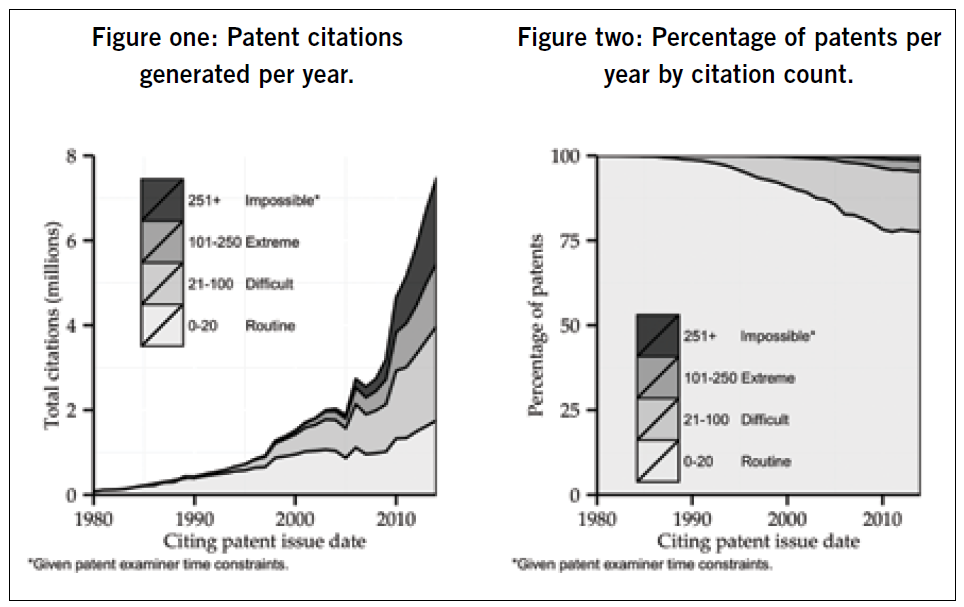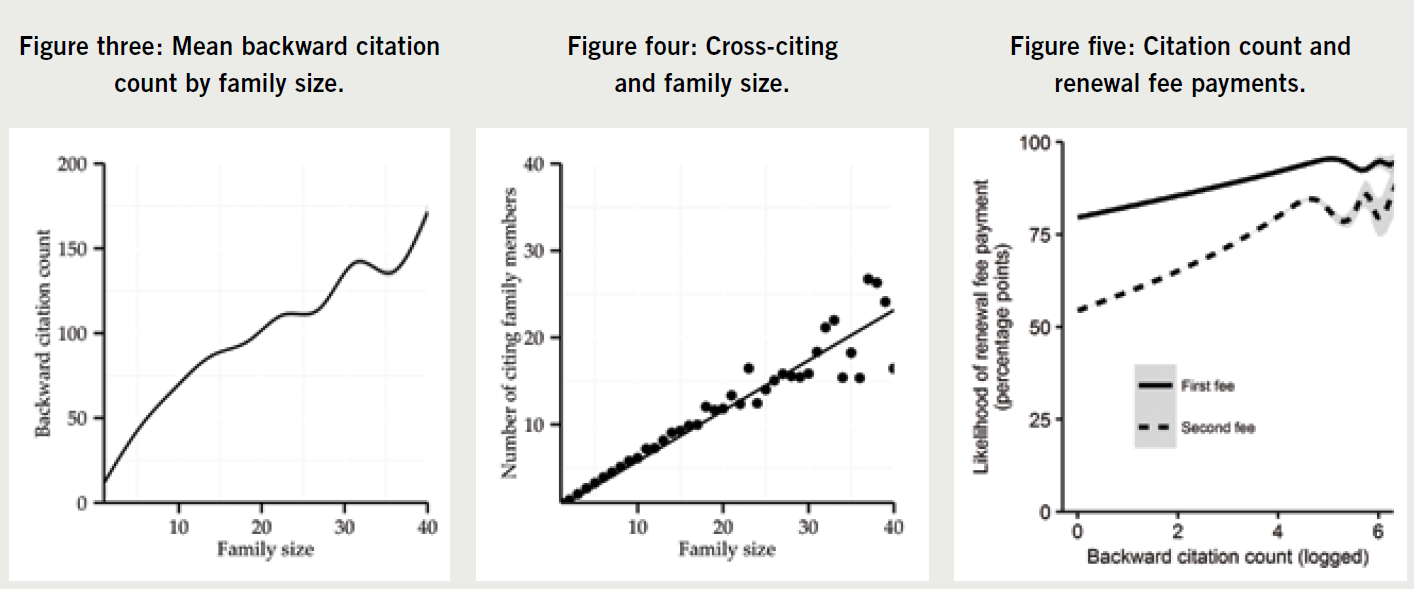CHEAT SHEET
- Establishing a standard. A court can infer intent to deceive at the summary judgment stage if the record establishes that the applicant knew of the information, knew or should have known the materiality of the information, and the applicant did not provide a credible explanation for withholding.
- Perspectives abroad. In recent years, over half of US patent applications list an investor living outside of the United States. It is important for global legal departments operating inside of the United States to stay on top of issues associated with inequitable conduct and the duty of disclosure.
- Plan of attack. When designating an approach to review, in-house counsel can either elect to conduct a “targeted review,” where the department manually reviews each reference to determine whether it’s material to prosecution, or a “cross-citing,” where the department automatically copies citations from every patent related to the applicant. To reduce risk, cross-citing is typically used for high-volume patents.
- Standardize and streamline. Incorporating a standardized workflow using modern search technology will become a critical defense for in-house counsel against improper disclosure allegations. By using “smart citing,” applicants can demonstrate to future courts that they did not intend to mislead or deceive the examiner.
In stark contrast to most of the world, patent applicants in the United States face a statutory duty to disclose all prior art known to the applicant to the US Patent and Trademark Office (USPTO). The duty is broad in scope — the term “applicant” includes any inventor, assignee, or lawyer associated with the application. Failing to disclose such information can render a patent unenforceable, even if that information should have been known to the applicant and they weren’t aware.* Applicants attempting to comply with the duty of disclosure therefore face two dilemmas. First, should an applicant manually review known references, or should they simply “cross-cite” any and every relevant reference that has ever crossed their desk? Second, should an applicant go further and search for prior art that is not actually known to them, unearthing new references and compounding the risks and costs associated with disclosure? No strategy is fail-safe, and patent holders now face improper disclosure allegations in 40 percent of patent cases. In-house counsel, in particular, could be in the dark about best practices if they are unsure how such strategies play out in the patent office. Understanding best practices is especially important for foreign patent applicants, who are less likely to be familiar with the unique disclosure rules of the USPTO.
* J.P. Stevens & Co. v. Lex Tex Ltd., 747 F.2d 1553, 1560 (Fed. Cir. 1984). It’s important to note that the applicant is only required to reveal known information, not to search for new information. The “should have known” part of the requirement is not a search requirement. Instead, an applicant may be deemed to “should have known” of references that were, for example, cited in a related patent application owned by the same applicant.
This article examines the risks and costs associated with the duty of disclosure for in-house counsel. Using big data methods and internal data from the USPTO, we summarize recent academic research on this question. We also describe how new technologies can help you standardize your workflow and lower the cost of your company’s prior art search, so you can plan for how courts may view your effort to comply with the duty of disclosure. Because most patent applications at the USPTO are filed by foreign applicants, these issues are particularly relevant to legal departments all over the world, even though the requirements are specific to US law.
The duty of disclosure in patent law
Some text and citations from section three are borrowed with permission from Kuhn (2011).
To understand the duty of disclosure, it’s helpful to review recent caselaw. Since revealing information to examiners may not seem to be in the best interest of an applicant, the USPTO imposes on “[e]ach individual associated with the filing and prosecution of a patent application . . . a duty of candor and good faith in dealing with the [Patent] Office.” The duty of candor is not merely a negative obligation to abstain from fraud, but also includes an affirmative “duty to disclose to the Office all information known to that individual to be material to patentability.” Patent applicants who fail to comply with the duty of candor risk having a patent ruled unenforceable in an infringement action. To establish a prima facie case of inequitable conduct, the defendant must demonstrate that the “applicant, with intent to mislead or deceive the examiner, fail[ed] to disclose material information or submits materially false information to the PTO during prosecution.” If the defendant can show that threshold levels of materiality and intent are met, then the court will balance the materiality and intent with the equities of the case to determine whether to render the patent unenforceable. Importantly, the duty of candor is relatively unique to the United States. While some foreign patent offices encourage disclosure, few of them impose penalties for a failure to provide references.
Exceptions exist. For example, Israel imposed a more stringent disclosure requirement in 2010, and Rule 141 of the European Patent Convention requires an applicant to provide a copy of any search report issued for the patent application by a different patent office.
In practice, none of the three prongs of the inequitable conduct doctrine — materiality, intent, and balancing — have historically worked in favor of the patent applicant.
In practice, none of the three prongs of the inequitable conduct doctrine — materiality, intent, and balancing — have historically worked in favor of the patent applicant. Regarding materiality, the US Federal Circuit has employed a broad “reasonable examiner” standard that essentially holds any reference to be material that a reasonable examiner would deem relevant to prosecution. Intent to deceive is typically “proven by circumstantial evidence because direct evidence of intent is rarely, if ever, available.” Although the precise standard for intent has long been unclear, the Federal Circuit has inferred intent both on the basis of gross negligence, and on the grounds that the applicant should have known that the uncited documents were material. Indeed, a court can even infer intent to deceive at the summary judgment stage in cases where “there has been a failure to supply highly material information and if the summary judgment record establishes that (1) the applicant knew of the information; (2) the applicant knew or should have known of the materiality of the information; and (3) the applicant has not provided a credible explanation for the withholding.” The balancing test provides little protection for applicants, since there are “few reported cases in which a court has found both thresholds were satisfied, but nonetheless exercised its discretion at the balancing stage to refuse to find inequitable conduct.”
Recent cases decided by the US Court of Appeals of the Federal Circuit suggest a retrenchment in favor of patent holders. In Therasense, Inc. v. Becton, Dickinson & Co., 649 F.3d 1276 (Fed. Cir. 2011) (en banc), the court defined materiality as requiring a butfor cause of issuing the patent, with an exception for “egregious affirmative acts of misconduct.” However, the Federal Circuit recently held that withholding information can be the but-for cause of issuing a patent even if the withheld information would not render any claim of the patent to be invalid in court — again opening the door to a broad interpretation of the materiality requirement. Moreover, although the stringency of the inequitable conduct doctrine seems to have receded somewhat in recent years, the application of the doctrine has, throughout its history, been inconsistent and cyclical. For example, a scholar writing in 1988 cited A.B. Dick Co. v. Burroughs Corp. as “a high watermark in assessing blame for ‘inequitable conduct,’” despite the doctrine’s later expansion far beyond the limits established in the late 1980s.
International patent applications
In recent years, over half of US patent applications list a lead inventor as an individual living outside the United States. However, the United States is relatively unique in having a duty of disclosure. In a family of related international patent applications, the patent applicant is generally obligated to disclose known references to the USPTO whether or not those references were also cited by a foreign patent office. Although some patent offices around the world encourage patent applicants to disclose references, few patent offices outside the United States impose penalties for failing to inform the patent office of prior art references known to the patent applicant. For example, the European Patent Office encourages patent applicants to submit references, but the norm for patent applicants is not to disclose. Accordingly, it is particularly important for legal departments globally that are less experienced with the US legal system to stay on top of issues associated with inequitable conduct and the duty of disclosure.
International applications with related patents in different jurisdictions tend to be of high value and also carry a heightened risk of inequitable conduct due to the relatively large number of prior art references unearthed across the family of related applications. International applications often receive a formal “search report” that lists references and categorizes them by relevance. Given the nature of these reports, it is very difficult for a patent holder to argue that a reference included in the report was either (1) not known to the patent holder or (2) not material to the examination of the corresponding patent application in the United States. Thus, a robust compliance strategy is essential.
Tactics to reduce risk
Targeted review or cross-citing?
Patent applicants face two dilemmas when tailoring their compliance efforts, the first being how to determine whether to cite known references. When a company owns a large patent portfolio, a new patent application is often related by technology or patent priority to many other US or foreign patents and applications. Each of these related applications may unearth new references via examiner-provided citations or PCT search reports, and the Federal Circuit has found inequitable conduct in cases where applicants have neglected to inform the patent examiner of these references from related cases.
One approach to compliance, called “targeted review,” requires manually reviewing each known reference to determine whether it is material to prosecution. A large family of patent applications, however, may unearth thousands of potentially relevant references, and anually reviewing each one may involve a prohibitive amount of time and cost. However, as discussed later, new technology may help to make “targeted review” a more viable strategy in the future. Furthermore, the decision whether to cite a particular reference is one-sided: Courts and the patent office have never imposed penalties for citing a reference that turns out not to be material.* Alternatively, choosing not to cite a reference risks later allegations of inequitable conduct.
* But see eSpeed, Inc. v. Brokertec USA, L.L.C., 417 F.Supp.2d 580, 598 (D. Del. 2006) (chastising the patentee for having buried false statements in a “blizzard of paper”).
Another approach to compliance, called “cross-citing,” involves automatically copying citations from every patent/application related in any way to the applicant. This approach avoids a manual review of references and reduces the risk of inequitable conduct allegations for failure to cite. However, cross-citing creates an administrative burden to track and manage the citation process. When dealing with a large portfolio of patent applications, cross-citing can require tracking the citation of thousands of references across 20 or more cases. Further, cross-citing creates the danger that an applicant will include most of, but not quite all of, such references.
As a result of cross-citing, recent years have seen an explosion in the number of patent citations submitted to the USPTO. These citations are not evenly distributed over all patents but are generated disproportionately by a small but growing portion of patents that cite a very large number of references. Figures one and two plot patent citation patterns over time and divide patents into groups based on the practical ability to individually review references given the time and cost constraints faced by in-house counsel and patent examiners.

Which strategy should in-house counsel choose?
In practice, patent applicants increasingly adopt the cross-citing strategy for large families of high-value patents to reduce risk and to address the large number of potentially relevant references that are often uncovered for these cases. However, applicants often stick to the targeted review strategy for isolated and lower-value patents because the stakes are lower and because these patents typically unearth far fewer references to review (see sidebar below). However, neither strategy is perfect, and both can lead to allegations of withholding key references or misleading a patent examiner. In section four, we argue that new technology based on textual analysis of every patent at the USPTO can help solve this dilemma by standardizing the review process and providing a defensible justification as to which references to cite when many are available.
Cross-citing
The cross-citing approach is usually associated with large patent families. As shown in figure three, patents in larger families tend to cite more references. Further, as the number of patents in a US patent family increases, so does the number of times that a given reference appears as a citation across the family. For instance, if a patent is in a family of 20 cases related by domestic priority claims, then a reference cited by the patent will also be cited by 13 members of the family, on average (figure four).
Patent applicants are also more likely to cross-cite high-value patents. As shown in figure five, as the number of citations made by a patent increases, so does the likelihood that the first and second renewal fees for the patent are paid. Renewal fee payments are a key indicator of patent value, because spending money to keep a patent in force is worthwhile only for valuable patents. The same logic holds for cross-citing, which often involves considerable administrative expense.

To search or not?
Patent applicants also face a second dilemma: whether or not to search for related patents not yet known to the applicant. Although applicants do not have a duty to search for prior art, searching provides numerous advantages. Most importantly, patent applications can be tailored to reflect the prior art, which can expedite patent prosecution and improve the claim coverage for patents at issue. Patent applicants can also avoid filing applications on technology that has already been discovered, reducing costs and focusing the effort on the applications that matter. Finally, knowledge of the prior art can help to shape the direction of future research and development. As an added bonus, searching the prior art and exhaustively citing from those search results can help convince a patent examiner, and potentially a jury down the road, that a patent on the underlying invention is warranted.
However, searching for a related patent is often difficult, expensive, and inconclusive. In-house counsel may lack the time and expertise to conduct a thorough search, and many companies therefore outsource the process to a specialized firm. Monitoring and reviewing the effort exerted and quality produced by such firms, however, also presents additional challenges. In any case, a search is likely to unearth a new set of references, compounding the dilemmas discussed earlier. In practice, the decision as to whether to search often depends on strategic considerations relevant to a specific company. If a well-funded patent department wishes to develop the strongest possible patent protection for an important new area of technology — and the company is confident in the novelty and quality of the new ideas — then searching for related patents can be crucial to achieving that goal. If a company instead wishes to acquire as many patents as possible in an already-crowded field (i.e., a “scattershot” approach), then resources expended on search would likely be better used in filing and prosecuting more patent applications.
Administrative cost of citations
Cross-citing can be an expensive strategy. Law firms typically charge a fixed fee of about US$250 to file an Information Disclosure Statement (the USPTO form to cite prior art), as well as about 0.2 hours of attorney time at around US$500/hour. Thus, each IDS can cost about US$350. A family of 10 related patent applications will constantly unearth new references, for instance via examiner-provided patent citations. Each application will thus likely require the filing of three to five IDS forms, resulting in a per-year bill of up to US$17,500 for duty of disclosure compliance alone when adopting a cross-citing strategy.
An approach of manual targeted review can be even more expensive. A family of 10 patent applications could easily unearth 200 references through foreign search reports and examiner-provided citations. Even if reviewing a reference requires only 10 minutes of attorney time, reviewing all references would require approximately 34 hours, for a total of US$17,000 at US$500/hour. However, the references deemed relevant must still be cited to the patent office, so even if the number of IDS forms is reduced to two per patent, the total cost of compliance would still be US$24,000.
Applicant citations matter
Courts have long emphasized the importance of full disclosure, and applicants generally incur considerable expense and significant risk in attempting to comply with that requirement. Nevertheless, some scholars cast a dim view on applicants’ compliance efforts. Lampe (2012) claims that applicants strategically withhold between 21 percent and 33 percent of relevant citations from the patent office. Cotropia, Lemley, and Sampat (2013) argue that patent examiners generally ignore applicant-submitted prior art citations in favour of the examiners’ own search results when formulating novelty and non-obviousness rejections. Hegde and Sampat (2009) contend that, in contrast to examiner-submitted citations, applicant-submitted patent citations are poor predictors of private patent value. Why require patent applicants to disclose prior art and risk a ruling of inequitable conduct if applicant patent citations are meaningless?
More recent research, however, demonstrates that applicant patent citations actually play an important role in patent examination (Kuhn, Younge, & Marco, 2016). Younge and Kuhn (2015) develop a similarity model that analyses the full text of each US patent issued and calculates the degree of similarity between every pair of issued patents (the results cover 14 trillion values and 296 Terabytes of data). Kuhn et al. (2016) use this data to show that applicant citation “quality” has declined over time, but not when controlling for the increase in citations-per-patent. Kuhn et al. (2016) also employ internal USPTO data to demonstrate that most of the citations defined by Lampe (2012) as “strategically withheld” were in fact not withheld at all. Further, although patent examiners do prefer to use their own search results when formulating novelty and non-obviousness rejections, misleading data led scholars to severely overestimate this bias. In fact, applicant-submitted references play a crucial role in supporting the novelty and non-obviousness rejections that help to shape patent claims, and (in contrast to previous findings) forward applicant citations more strongly predict private patent value than examiner citations (Kuhn et al., 2016).
These new results present a mixed picture for patent applicants. On the one hand, applicant-submitted patent citations can result in novelty and non-obviousness rejections that reduce applicant’s claim scope. On the other hand, ensuring that the patent examiner reviews these references during patent examination can reduce the chance that a patent is invalidated for being “too broad” during subsequent litigation. In the following section, we discuss how new technology can help patent applicants craft claims that withstand the scrutiny of patent examiners and courts, ensuring that the applicant can secure broad but valid protection.
Search options
KEYWORD SEARCHING:
Pro: Free, simple
Con: Potentially incomplete, difficult to document
Examples: USPTO Patent Full-Text Databases and Google Patents
OUTSOURCED SEARCH:
Pro: Specialized researchers
Con: Often slow and expensive
Example: Clarivate Analytics
AUTOMATED SEARCHING:
Pro: Fast
Con: Unknown risks of missing prior art
Example: DataNovo
BIG DATA/AI:
Pro: Fast, comprehensive, and scientifically validated
Con: Evolving technology
Example: Patent Research Foundation
Standardizing your workflow with new technology
Although it appears that the Federal Circuit has slowed its expansion of the duty of disclosure in recent years, applicants must still plan for changes to the law that can happen over the 20 year life of a patent. Applicants cannot afford to rely too heavily on the current state of the law, for standards change — and changes to the standard of care for the duty of disclosure may be tracking changes in technology. As applicants became better able to track relevant references across a large portfolio of related patent applications, courts have increasingly expected them to do so. It is not too much of a stretch, therefore, to believe that the duty of disclosure will continue to evolve as technology improves. Indeed, courts have suggested in dicta that flooding the patent examiner with an excessive number of irrelevant citations may constitute inequitable conduct and potentially lead to the unenforceability of the patent.* Further, the USPTO has attempted to curb cross-citing in the past using administrative rulemaking — but has so far been unsuccessful. Thus, nothing about the duty of disclosure is certain in the long term.
* But see eSpeed, Inc. v. Brokertec USA, L.L.C., 417 F.Supp.2d 580, 598 (D. Del. 2006) (chastising the patentee for having buried false statements in a “blizzard of paper”). “In order to satisfy the intent prong of the test for inequitable conduct under a theory of burying references, a defendant would likely need to prove that the patentee knew that a particular reference was material and buried it in a list of references believed to be significantly less material.” Kuhn (2011).
Advances in technology have provided patent applicants with a number of free search tools such as Google Patents and the USPTO full-text patent databases. Using free services, however, still requires considerable effort since the searcher must select keywords for the search engine. Because any particular combination of keywords can easily result in missing important patents, the searcher must try to identify different combinations of keywords to have the best chance of finding the most relevant prior art. Each combination of keywords then returns a new set of search results, which must be manually reviewed and cross-referenced with other search results to determine which references are most important. Accordingly, keyword-based searching is more art than science, and even the best keyword-based searching risks missing or misevaluating relevant prior art references. Perhaps most importantly, it is extremely difficult to document a free-form search in such a way as to demonstrate that crucial references were not first identified, but then withheld. In effect, a free-form search on keywords actually imposes another layer of cost and risk to a search strategy that ostensibly is “free.”
Patent search companies and outside counsel provide alternatives to employing free search tools. Expert searchers or patent attorneys who specialize in an area of technology can often find prior art that would be missed by a less-experienced searcher, and a careful and manual prior art search may be the best course of action for the most valuable patents. However, most patent applicants do not choose to engage such a service because of the considerable expense involved. Commissioning a prior art search can cost anywhere from US$500 to US$10,000, depending on the complexity of the technology and the exhaustiveness of the search. Further, manual search can take weeks to complete, as deliverables from contractors vary, and the patent applicant has no way to verify the extent of time or care that was exerted to complete the search if challenged about it at a later date. To the degree that manual searching is not systematic or amenable to review, assessing the quality of such searches is difficult and reliance on such searches may leave one with an unknown degree risk.
We are unaware of any evidence as to the quality and variability of results returned by search providers.
New technology is emerging that may revolutionize patent searching. Researchers are working to apply “big data” technologies, such as computational linguistics, high-dimensional visualization, and cloud computing to analyse patent filings and data. The vector space similarity model, and used by the Patent Research Foundation, is one example of how new technology may bear upon the duty of disclosure, and may help to solve the two dilemmas.* Using such a tool, a patent applicant can easily search publicly available prior art to produce a rank-ordered list of potentially relevant patent references, and work down the list in an efficient manner — starting with the most relevant references first. And if challenged n court, patent applicants can use the textual similarity value from such a report as a defensible threshold for determining which references to cite and which not to cite, which may help to provide the “credible explanation for the withholding” demanded by the Federal Circuit in Ferring B.V. v. Barr Labs (Fed. Cir. 2006). In other words, a vector space similarity model may be used to search for related patents while also avoiding the problem of specifying keywords, as well as the time, expense, and unobservable effort involved in contracting out searches to third parties. Such a “smart citing” strategy can provide many of the benefits of a “targeted review,” without the expense and risk of manually determining which references to cite and which not to cite. Patent applicants can also ensure that patent examiners received the most relevant references without being overwhelmed by irrelevant and low-quality citations, thus avoiding the potential pitfall noted by the court in eSpeed v. Brokertec, 417 F.Supp.2d at 598 (D. Del. 2006).
* While these new technologies are still in their infancy, big data processing capacity will likely make these solutions highly cost-effective, whether improving in-house counsel efficiency and capacity, reducing outside counsel costs, or as a more transparent and reliable alternative to low-cost, foreign labor searching.
We expect that a standardized workflow using modern search technology will become a critical defense against improper disclosure allegations for patent applications, as well as an opportunity to avoid the sunk costs associated with filing a patent application on technology that is already described in the prior art. A consistent practice of “smart citing” and using up-to-date technology will also help applicants demonstrate to future courts that they did not intend to mislead or deceive the examiner. To that end, we have been working with the Patent Research Foundation to help move new technologies out of the academic lab and into practice. Hopefully, better searching and disclosure of references will help to make the patent system more transparent and reliable for all.
NOTES
Duty of Disclosure, 37 C.F.R. § 1.56.
Christian M. Mammen, Controlling the “Plague”: Reforming the Doctrine of Inequitable Conduct, 24 BERKELEY TECH. L. J. 1329, 1358 (2010).
Digital Control Inc. v. Charles Mach. Works, 437 F.3d 1309, 1313 (Fed. Cir. 2006) (citing Norian Corp. v. Stryker Corp., 363 F.3d 1321, 1330-31 (Fed. Cir. 2004)).
See Rule 141 of the European Patent Convention.
Star Scientific, Inc. v. R.J. Reynolds Tobacco Co., 537 F.3d 1357, 1367 (Fed. Cir. 2008).
See, e.g., id.; Digital Control Inc. v. Charles Mach. Works, 437 F.3d 1309 (Fed. Cir. 2006).
Mammen, supra note 1, at 1338.
See, e.g., id. at 1336-40.
Brasseler, L.P. v. Stryker Sales Corp., 267 F.3d 1370, 1380 (Fed. Cir. 2001).
J.P. Stevens & Co. v. Lex Tex Ltd., 747 F.2d 1553, 1560 (Fed. Cir. 1984).
Ferring B.V. v. Barr Labs., Inc., 437 F.3d 1181, 1191 (Fed. Cir. 2006), cert. denied, 549 US 1015 (2006).
Mammen, at 1344 (citing Rentrop v. Spectranetics Corp., 550 F.3d 1112, 1120 (Fed Cir. 2008); Informatica Corp. v. Bus. Objects Data Integration, Inc. 489 F. Supp. 2d 1060 (N.D. Cal. 2007)).
American Calcar v. American Honda (Fed. Cir. 2014).
See, e.g., John F. Lynch, An Argument for Eliminating the Defense of Patent Unenforceability Based on Inequitable Conduct, 16 AIPLA Q.J. 7, 8 (1988) (citing A.B. Dick Co. v. Burroughs Corp., 798 F.2d 1392 (Fed. Cir. 1986)).
United States Patent and Trademark Office, Dep’t of Commerce, Media Advisory, 06-41 (July 6, 2010).
Ferring B.V. v. Barr Labs., Inc., 437 F.3d 1181, 1191 (Fed. Cir. 2006), cert. denied, 549 US 1015 (2006).
References
Cotropia, C. A., Lemley, M. A., & Sampat, B. (2013). “Do applicant patent citations matter?” Research Policy, 42(4), 844-854.
Hegde, D., & Sampat, B. (2009). “Examiner citations, applicant citations, and the private value of patents.” Economics letters, 105(3), 287-289.
Kuhn, J. M. (2011). “Information Overload at the US Patent and Trademark Office: Reframing the Duty of Disclosure in Patent Law as a Search and Filter Problem.” Yale Journal of Law and Technology, 13(1), 3.
Kuhn, J. M., Younge, K. A., & Marco, A. (2016). “Patent Citations: An Examination of the Data Generating Process.”
Lampe, R. (2012). “Strategic citation. The Review of Economics and Statistics,” 94(1), 320-333.
Younge, K. A., & Kuhn, J. M. (2015). “Patent-to-Patent Similarity: A Vector Space Model.” Available at SSRN.






